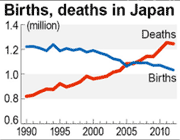| |
|
| |
|
 |
Supply
Chain by the Numbers |
| |
|
| |
- Dec. 8, 2016 -
|
| |
|
| |
|
| |
|
| |
Amazon has Sights Set on Brick and Mortar Grocery Stores; UK Retailers and CPG Companies Tussle over Pricing; Population in Japan Headed to Scary Lows; Smithfield Foods Targets Manure to Reduce CO2 |
| |
|
| |
| |
| |
2000+ |
 |
|
|
| |
| |
|
25%
|
|
That's by much pork producing giant Smithfield Foods - acquired by a Chinese company in 2016 - plans to reduce its greenhouse gas emissions from its entire supply chain over the next eight years. The announcement is noteworthy in part because the meat industry generally has been slow to adopting sustainability efforts and been a major target of criticism from environmental groups. Livestock is responsible for 14.5% of human-induced greenhouse gas emissions, with meat and dairy production accounting for the bulk of it, according to a 2013 United Nations report. The company says that to reach its goal it will reduce use of fertilizer used to grow grain for pig feed, install systems to extract natural gas from manure, improve transportation routing and more. The large manure pools associated with pig farms are a major focus, with plans to cover the pools and add systems called anaerobic digesters that convert the methane they produce into electricity or natural gas. Now you know. Smithfield says it hopes to reduce operating costs and bolster its brand perception from the efforts. |
| |
| |
|
| |
| |
87 Million |
 |
Incredibly, that is the level of population that Japan is predicted to fall to by 2060, down dramatically from around 127 million currently. That according to an article in the UK's Independent newspaper this week, citing projections from Futoshi Ishii, director of population dynamics at the National Institute of Population and Social Security Research in Japan. In fact, Ishii says that Japan's population decline will break a new record every year from now until the 2060s. The obvious cause: a very low birth rate. Japan has one of the lowest birth rates in the world, with just 8.4 children being born per 1,000 inhabitants over the last five years, likely to head still lower. That compares to a rate of about 12.5 in the US. While the situation in Japan is especially acute, there are falling population issues all over the world, in fact almost everywhere but Africa. This demographic tsunami will have profound impact on supply chains - and society. |
| |
| |
|
|
|
| |
 |
 |
| |
|
|
| |